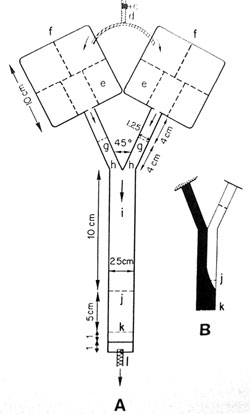





 Pair
Formation
Pair
Formation
A big question for shrimp-goby researchers had always been, how do the shrimp and goby find each other? In other words, who finds who and how? Finally, in 1981 Ilan Karplus published a paper entitled Goby-shrimp Partner Specificity. II. The Behavioral Mechanisms Regulating Partner Specificity whereby he experimentally figured out what attracts shrimp and goby to each other.
He discovered that the mechanism for shrimp is different for that of gobies. In an nicely designed experiment he looked at two different methods of attraction, chemical and visual.
Chemical Attraction:
The diagram to the right shows the set-up used by Karplus (1981). One
partner was placed in the bottom of the V while the other was placed in
one branch of the V. A partition was raised and the shrimp or goby could
travel up the V into the water stream. They found that there was no difference
in which side the goby went into, regardless of what kind of shrimp was
in the system. For shrimp the story is different. Shrimp were attracted
to the side of the Y that had their ‘wild’ goby partner.
 Optical
Attraction:
Optical
Attraction:
To test the visual attraction of the goby/shrimp to their partner, the
individuals were placed in a clear cylinder in the middle of the aquarium
with their partner on one side or the other. Tests were then conducted
to see if, when the cylinder was raised, which side they attempted to
go to. Karplus discovered that shrimp showed no preference for any side,
no matter what was behind the glass. Gobies were different. They showed
a preference for their particular ‘wild’ shrimp partner.
What does this mean?
In reality what does this mean? Does it prove who finds who in the relationship?
Maybe not. In the wild, how often does a goby visually see a shrimp? Most
of the time, the shrimp are inside their burrows. It does show that there
is a strong attraction for both shrimp and goby to their particular partner,
whether it be visual for the goby or chemical for the shrimp. It also
shows that the shrimp and goby are sensorialy set up very differently.